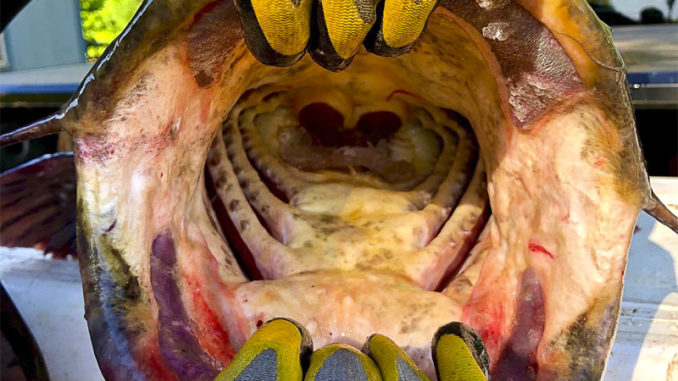
Trotlines or stump lines? Here’s how to ‘string up’ some big Opelousas catfish, aka flatheads.
Dale Taylor took a 40-year vacation from catching Opelousas catfish, aka flatheads, but he found out when he returned last year that nothing has changed.
“My grandson, Daniel, wanted to put out some stump hooks last year and asked me to help,” Taylor said. “I told him it had been 40 years since I did it, but I’d be glad to show him what I know. It was early in the year, so I told him a trotline would work best. We started putting out some lines, and the results were remarkable.”
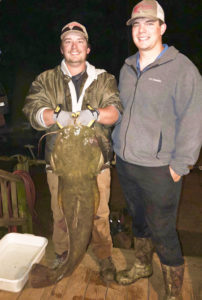
Some people may not consider setting out trotlines, limb lines or stump hooks as a regular fishing activities, but they’ve never played tug-of-war with a 50-pound flathead or tried to hoist one into the boat. And they’ve never patterned catfish just like they would a bass or crappie.
“I tell you what,” Taylor said. “You can’t just go out and drop a line in the water and catch a big Op. You have to know their feeding habits, and you can use electronics to help find the best spots, just like other fishing.”
Taylor should know. He’s an expert bass and crappie fisherman — and all-around outdoorsmen — and his grandsons Daniel and Dakota have picked up right behind him. What they know about catching big flatheads can help you enjoy this sport, too.
“This past season, we started early and got on some really big ops,” Taylor said. “Our two biggest were 50 and 54 pounds. We caught both of them on a trotline when the water was still cool on the bottom and the baitfish were hanging out there. That’s the key on what type of lines to fish and how deep to fish; it’s water temperature. In the early summer, they’ll feed deep. But as the summer warms up and the thermocline forms in the water, those fish will move up shallow and start feeding. They hang out in the same places, but they will go wherever to follow the baitfish to feed.”
Patterning flatheads
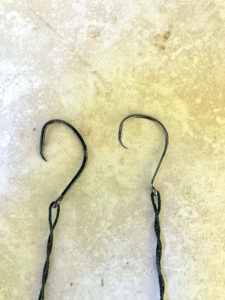
Taylor said catfish can live in oxygen-depleted water, and they often hang out deep where other smaller fish can’t survive in the summer. But when the dinner bell rings, they are on the prowl.
Taylor finds ideal situations for flatheads — also called Ops (short for Opelousas), goujon, pied cat, Johnnie cat and shovelheads in different parts of the country — on his home water, 16,000-acre Lake D’Arbonne. But almost any large lake in Louisiana has a good population of these fish.
“We’ve got an ideal situation on a submerged creek right behind our house,” he said. “The main creek has a well-defined feeder creek that is 3 to 4 feet wide and pretty deep. It’s like a highway for those fish to migrate up and down, and they’ll come out on the flats to feed. There’s a lot of trial-and-error involved, but once you find where they are traveling, that’s where you need to keep your lines.”
Taylor said some fishermen give trotliners a bad name by putting out lines and leaving them unattended. That’s irresponsible, he said. Never leave a line out that you are not actively fishing. And take them up, don’t just cut them and let them sink to the bottom.
“The correct way to put out a trotline is to tie the line between two stumps and mark it on both ends with a highly visible float or white jug,” he said. “Then, make sure you sink the line down far enough to keep it out of people’s way. We put weights on each end, just a few feet from the stump and also in the middle. It keeps the line out of the way, plus puts the bait down where the fish are going to be feeding. When you aren’t running your line every day, take it up and get it out of the lake.”
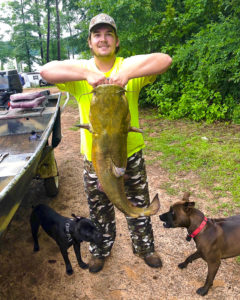
A bream breakfast
Taylor said the best bait for big flatheads is big bream. A flathead catfish will eat almost anything that moves and makes a vibration, but bream is the best and most readily available.
Taylor uses 21-gauge black nylon trotline cord and No. 7/0 Gamakatsu or B’n’M hooks. He doubles his drop lines and use swivels to keep big fish from twisting off. That’s a must for big Ops, he said. Then, they bait the hooks with big bream and let the cat’s appetite and keen senses do the rest. He always wears a good pair of gloves, because these cats have a mouthful of teeth that are like super-coarse sandpaper, and they can gnaw the skin right off your hand.
“Big Ops use those whiskers to feel for vibration, just like a bass does with it’s lateral line,” he said. “They feel that vibration and then find where it’s coming from and eat it. They like big bait because they want to feel like it’s a mouthful.”
Switch to stumps
In late summer, the Taylors switch to stump hooks. They use the same gear but move up more shallow into 5 to 6 feet of water. They look for big stumps, favorites of big Ops.
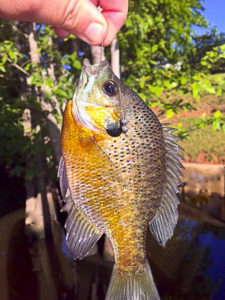
“Those fish will find a big stump and start at the bottom, circle the stump and eat anything they find around it all the way to the surface,” he said. “You want to put your drop line about halfway up and leave some line between your weight and the baitfish so it can swim around freely and give off that vibration.”
Safety is paramount when dealing with these big fish. When you grab one in the mouth, it’s kind of like grabbing hold of an earthquake.
“It isn’t for the faint or heart, that’s for sure,” Taylor said. “It’s not quite as bad as noodling, where you can’t see what you are grabbing, but it’s a handful. In fact, I always keep a sharp knife right beside me, because if you get a hook in you while battling one of those big monsters on a line, it could be bad. You need to be able to cut the line. I always cut the drop line with the hook in it when I’m bringing in one of those big ones.”
Big ones, in this case, are really big. In just a few week stretch earlier this year, the Taylor trio landed more than 700 pounds of Ops. They don’t go to waste. Taylor carefully skins and cleans the fish, removes all the fat and silverskin and cuts them into one-inch cubes to fry. He said the white flesh of these fish is the best he’s ever eaten.
The ‘other’ catfish
While big Ops aren’t the target of rod and reel fishermen, some of the easiest fish to catch in the summer all across the state are blue and channel catfish. They can be caught on flats, around the banks, cypress trees and in almost any place you can catch bream. They provide great eating and lots of sport.
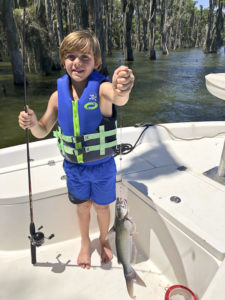
The typical way to rig for catfish in the 1- to 3-pound range is with 12- to 14-pound test line, hooks in the No. 6 to No. 10 range and with small BB shot weights to hold the bait down. Many anglers prefer longer-shank hooks, which allow the fish to get the bait in their mouth easier and make it easier to unhook fish.
Catfish are often picky eaters. You may see your cork begin to bob a bit, or feel a “tap, tap, tap” on your line if tight-lining without a cork. Don’t pull too quickly. Wait a few seconds until the fish has it before setting the hook to reel him in.
One word of caution: even the smallest of catfish have sharp spines in the dorsal and pectoral fins that contain a weak venom that really hurts if they puncture your skin. Handle them with care and if you do get stuck, wash and medicate the wound.


